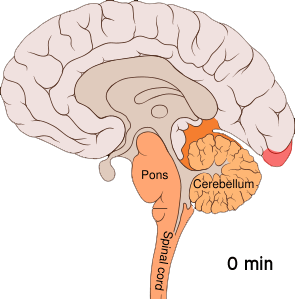 | ||
(Cortical) spreading depression or spreading depolarization (SD) is a wave of electrophysiological hyperactivity followed by a wave of inhibition. Spreading depolarization describes a phenomenon characterized by the appearance of depolarization waves of the neurons and neuroglia that propagates across the gray matter at a velocity of 2–5 mm/min. SD can be induced by hypoxic conditions and facilitates neuronal death in energy-compromised tissue. SD has also been implicated in migraine aura, where SD is assumed to ascend in well-nourished tissue and is typically benign in most of the cases, although it may increase the probability in migraine patients to develop a stroke.
Uses of the term
Neuroscientists use the term cortical spreading depression to represent at least one of the following cortical processes:
The scintillating scotoma of migraine in humans may be related to the neurophysiologic phenomenon termed the spreading depression of Leão.
Increased extracellular potassium ion concentration and excitatory glutamate contribute to the initiation and propagation of cortical spreading depression, which is the underlying cause of migraine aura.
Chronic daily administration of migraine prophylactic drugs (topiramate, valproate, propranolol, amitriptyline, and methysergide) dose-dependently suppressed frequency of SD induced by continuous cortical application of 1 M KCl solution. However lamotrigine (a drug with specific anti-aura action, but no efficacy in migraine in general) has a marked suppressive effect which correlates with its rather selective action on the migraine aura. Valproate and riboflavin were shown to have no effect on the triggering of cortical spreading depression though they are effective in migraine without aura. Taken together, these results are compatible with a causal role of cortical spreading depression in migraine with aura, but not in migraine without aura.
The gyrencephalic brain is capable of irregular and complex SD propagation patterns. The irregularities of the gyrencephalic brain cortex and the vasculature promote the presence of re-entrance waves, such as spirals and reverberating waves. The expansion of the wave then is less predictable and it is affected by the concentration of different molecules and gradients on the cortex.
Its triggers and propagation mechanisms, as well as clinical manifestations of SD, are a therapeutic target to reduce brain damage after a stroke or brain lesion.
